Advertisement
Published: June 12th 2018
June 8, 2018 I'm loving Verona - it's not so crowded and it's easier to walk around. Susan & Joe (on the concert tour with me) are going to the radio museum and I decided to tag along with them. We wanted to take bus #11 which picks up at our hotel, but a little elderly Italian woman was trying to tell us to go across the street (which is not really across) to go the right direction. We didn't understand and got on the bus going the wrong way. We rode to the end of the line, and then he turned around and we went back to the hotel. Then Nancy, Diana, & Mike got on. They didn't know where the correct bus stop was either and they flagged down the bus. Oh well, we made it to center of town.
The radio museum had all kinds of stuff: Marconi, original morse code, big & small radios, transistors, stuff from the war, tubes. My Dad would have loved this museum. I had seen enough after 45 minutes and Susan & Joe wanted to stay 3 hours so I made my way to the Arena. (I have no control
over the placement of the photos so my photos are mixed in with wikipedia & other website photos.)
The Verona Arena from Wikipedia:
The
Verona Arena (
Italian:
Arena di Verona ) is a
Roman amphitheatre in
Piazza Bra in
Verona,
Italy built in the first century. It is still in use today and is internationally famous for the large-scale
opera performances given there. It is one of the best preserved ancient structures of its kind. In ancient times, nearly 30,000 people was the housing capacity of the Arena. Nowadays, for security reasons, the maximum attendance is 15,000 people. The building itself was built in AD 30 on a site which was then beyond the city walls.
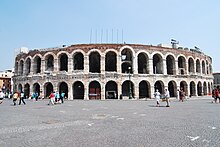
Verona Arena in 2009

Inside the Verona Arena
I managed to get a senior ticket that included the Maffeiano Museum, which has Greek & Roman items dating to 5th century B.C.
Maffeiano Lapidary Museum
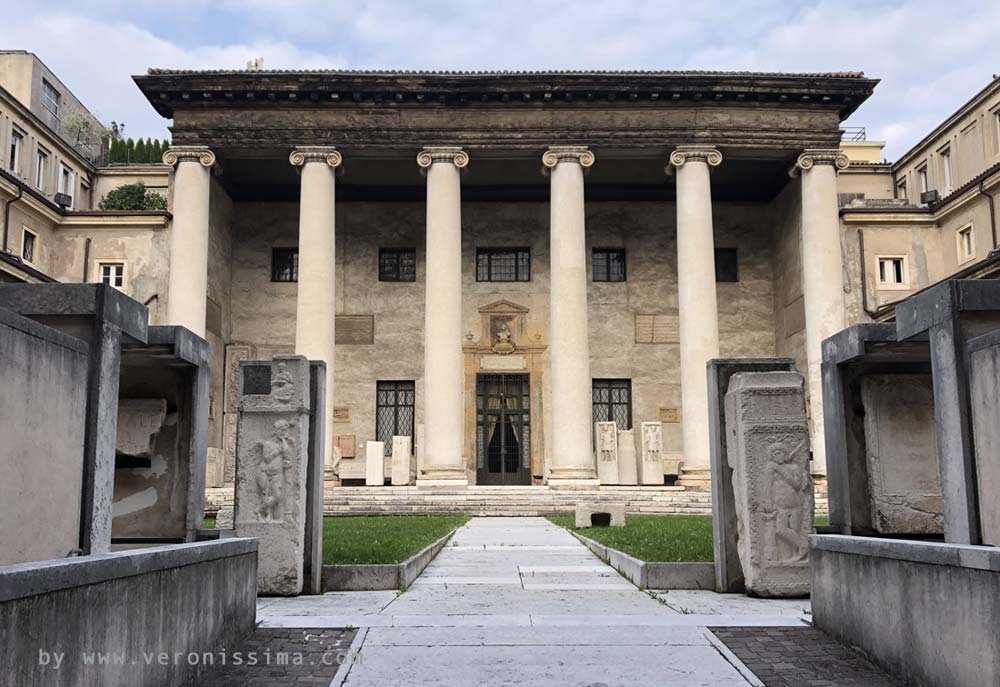
Founded in
1745 by
Scipione Maffei, eminent Veronese literary man who contributed with his huge personal collection of
Roman inscription, the
Lapidary Museum is probably the oldest public museums in the world. It was arranged in
a wing of the
Philharmonic Academy, a inner courtyard leading to the Philharmonic Theater of Verona. In 1982 the display was completely re-arranged according to modern and more scientific methods. The museum and especially its courtyard is a fascinating place where, together with a
tourist guide you will go through the great ancient Greek and Roman culture.
I had lunch in the square next to the Arena, then made my way to the Amphitheater by walking next to the Adige River and crossing the Ponte Pietra.
From Wikipedia: The
Ponte Pietra (
Italian for "Stone Bridge"), once known as the
Pons Marmoreus, is a
Roman arch bridge crossing the
Adige River in
Verona,
Italy. The bridge was completed in 100 BC, and the
Via Postumia from
Genoa to
Aquileia passed over it. It is the oldest bridge in Verona.
It originally flanked another Roman bridge, the
Pons Postumius; both structures provided the city (on the right bank) with access to the
Roman theatre on the east bank. The
arch nearest to the right bank of the Adige was rebuilt in 1298 by
Alberto I della Scala. Four arches of the bridge were blown up by retreating
German troops in
World War II, but
rebuilt in 1957 with original materials.
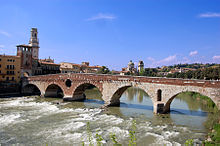
The arch at the far left is the only one which escaped destruction in 1945.
Archeological Museum
and Roman Theater
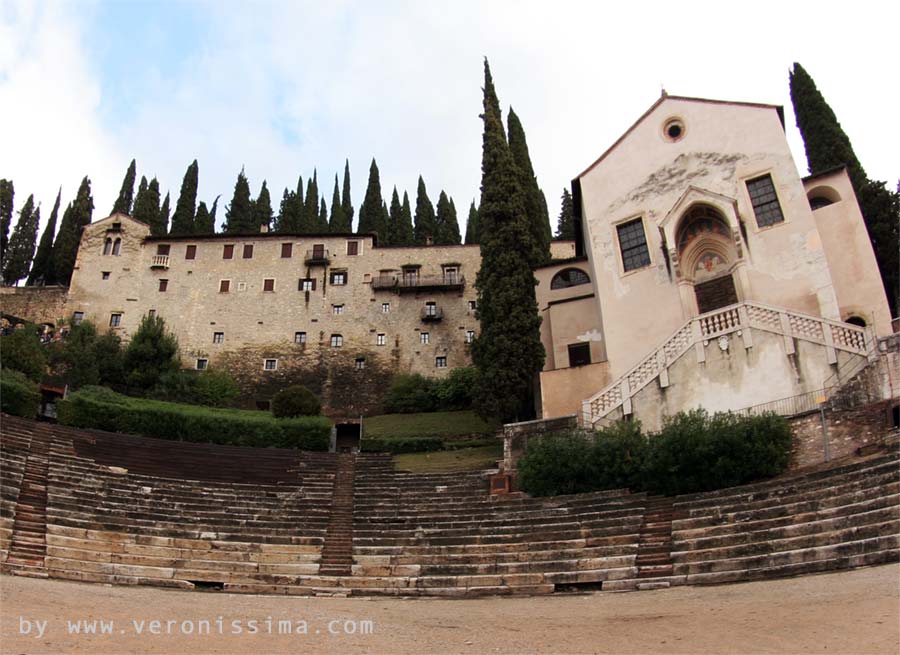
The memory of a legendary
Roman theater in Verona never faded after the fall of the Roman Empire and the dark ages of the barbaric invasions. As early as the 10th century, houses and a church were built on top of the theater, completely hiding the seating area and the stage. Famous Renaissance architects,
Andrea Palladio too, tried to imagine how the Verona theater might have looked like. Only in the 1800s Andrea Monga (1794-1861) a wealthy merchant, after purchasing the entire complex, conducted excavations and some demolitions. In 1904, the city of Verona bought the property and definitely brought the old theater of Verona back to life.




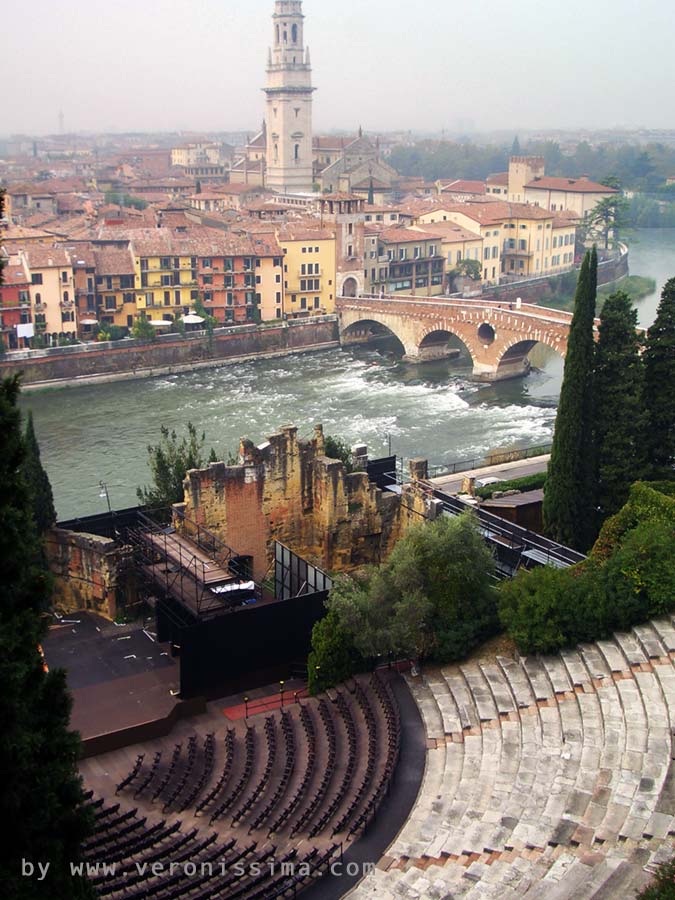
The wonderful panorama that can be admired from the cells of the old Convent of St Gerolamo. On the background the
Roman bridge (I century A. C.) and the episcopate whose tower was built using the stones from the scene of the Roman theater.<td
valign="top" width="10">




Only the church of Saints Siro and Libera was preserved and still nowadays, with a quite surreal effect, rises alone from the stone steps of the theater.
In 1923, the city of Verona created the
Archeological Museum in the cells, refectory and church of the old convent of St. Gerolamo. In it are exhibited
mosaics,
bronzes,
statues,
inscriptions, glass, ceramics and all the archeological finds collected all over Verona and its territory.
I'm surprised there is still an amphitheater there because they built all around it and on top of some of it. After going up & down stairs and walking around in the heat (it's been in the 80's every day, and last night we had a tremendous thunderstorm), I wanted to take the bus home. I asked alot of people but couldn't get an answer for how to take a bus from that location. I walked back towards a church where I had seen a #11 bus, and I got on the bus. Unfortunately I got on it going the wrong direction. I rode it to the suburbs, and then all the way back. Oh well, such is
life. I now know the entire #11 route.
Back at the hotel Diana & Mike took Nancy & I to a neighborhood that didn't have tourists, and we had a wonderful dinner. This neighborhood was about a 15 minute walk from our hotel, there were lots of restaurants, and no tourists as far as we could tell. It was the last day of school and the families & their children were celebrating with a meal.
After dinner Nancy & I ordered a cognac and the poor bartender was so flustered. This was his 3rd day on the job and he was so confused with the paperwork. For some reason he has to hand do the paperwork for each drink & get a signature. I can only guess that it is to keep track of the liquor. When Nancy found out he spoke Spanish they conversed quite well. (She lived in Mexico City for 10 years.) She had helped him before to make a Negroni for her. He seems very inexperienced as a bartender, and I felt for him with the ridiculous paperwork for every drink he sold.
Advertisement
Tot: 0.111s; Tpl: 0.013s; cc: 7; qc: 24; dbt: 0.0542s; 1; m:domysql w:travelblog (10.17.0.13); sld: 1;
; mem: 1.1mb






































PAMELA L BRYANT
non-member comment
Blog
I enjoyed your journey . . . . . . . and the pictures! Thank you for sharing your trip to Croatia, Slovenia & Italy!